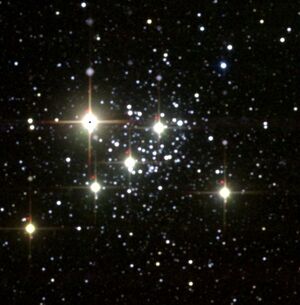Astronomy:NGC 7419
| NGC 7419 | |
|---|---|
 NGC 7419 in infrared, highlighting the five red supergiants, plus the foreground Carbon star MZ Cep at lower left Credit: 2MASS | |
| Observation data (J2000 epoch) | |
| Constellation | Cepheus |
| Right ascension | 22h 54m 20s[1] |
| Declination | +60° 48′ 54″[1] |
| Distance | 2,930+320 −260[2] pc |
| Apparent magnitude (V) | 13[1] |
| Apparent dimensions (V) | 2′[3] |
| Physical characteristics | |
| Other designations | Collinder 453 |
NGC 7419 is an open cluster in the constellation Cepheus. It is heavily reddened and notable for containing five red supergiants, the highest number known in any cluster until the end of the 20th century, but probably no blue supergiants.
Members
The brightest of the five red supergiants is the exceptionally cool MY Cephei.[4] It has a spectral type of M7.5 which is one of the latest spectral types of any supergiant, although analysis is made difficult by the lack of comparable standard stars.[5] It is estimated to have an effective temperature around 3,000 K[6] and a bolometric luminosity more than 100,000 L☉.[7] MY Cephei is a semiregular variable star with a brightness range of magnitude 14.4 - 15.3.[8]
The brightest hot stars in the cluster have a spectral type of BC2, indicating B2 stars with enhanced levels of carbon.[9] One has a bright giant luminosity class of II, while the other has a luminosity class of Ib-II, indicating it is either a bright giant or supergiant. The hotter stars of the cluster are visually faint due to around six magnitudes of interstellar extinction.[10]
The lack of blue supergiants, particularly in a cluster of just the right size and age to include five red supergiants, is unusual. Such low ratios of blue:red supergiants occur in low metallicity clusters, but NGC 7419 is young and has near-solar metallicity. Rapidly rotating stars may account for this evolutionary trend, encouraging high mass loss and rapid evolution of massive stars into red supergiants. This conclusion is also consistent with the high proportion of Be stars in the cluster.[4][10]
The age of the cluster is calculated to be 14±2 million years. Clusters of this age are expected to have a main sequence turnoff at spectral type B1, and this is seen in NGC 7419. 1,200 M☉ of B-type stars alone are observed, implying a total cluster mass of 7,000 - 10,000 M☉.[10]
Non-members
Visible in the same field and as prominent as the red supergiants in infrared images is the carbon star MZ Cephei, which is much closer to us than NGC 7419.[4] It is a slow irregular variable star with a range of 14.7 - 15.4.[8]
The visually brightest star in the core region of the cluster is a yellow giant, placed at around 500 parsecs by Gaia astrometry.[11] The even brighter nearby star HD 216721 is also a foreground object.[4] Further out still from the centre of the cluster is the 7th magnitude eclipsing binary V453 Cephei, around 250 parsecs distant from us.[12]
See also
References
- ↑ 1.0 1.1 1.2 "NGC 7419". SIMBAD. Centre de données astronomiques de Strasbourg. http://simbad.u-strasbg.fr/simbad/sim-basic?Ident=NGC+7419.
- ↑ Beasor, Emma R.; Davies, Ben; Smith, Nathan; Van Loon, Jacco Th; Gehrz, Robert D.; Figer, Donald F. (2020). "A new mass-loss rate prescription for red supergiants". Monthly Notices of the Royal Astronomical Society 492 (4): 5994–6006. doi:10.1093/mnras/staa255. Bibcode: 2020MNRAS.492.5994B.
- ↑ "SEDS Online NGC Database". Results for NGC 7419. http://spider.seds.org/ngc/ngc.cgi?N7419.
- ↑ 4.0 4.1 4.2 4.3 Caron, Geneviève; Moffat, Anthony F. J.; St-Louis, Nicole; Wade, Gregg A.; Lester, John B. (2003). "The Lack of Blue Supergiants in NGC 7419, a Red Supergiant-rich Galactic Open Cluster with Rapidly Rotating Stars". The Astronomical Journal 126 (3): 1415–1422. doi:10.1086/377314. Bibcode: 2003AJ....126.1415C.
- ↑ Beauchamp, Alain; Moffat, Anthony F. J.; Drissen, Laurent (1994). "The galactic open cluster NGC 7419 and its five red supergiants". Astrophysical Journal Supplement Series 93: 187. doi:10.1086/192051. Bibcode: 1994ApJS...93..187B.
- ↑ Messineo, M.; Brown, A. G. A. (2019). "A Catalog of Known Galactic K-M Stars of Class I Candidate Red Supergiants in Gaia DR2". The Astronomical Journal 158 (1): 20. doi:10.3847/1538-3881/ab1cbd. Bibcode: 2019AJ....158...20M.
- ↑ Davies, Ben; Beasor, Emma R. (March 2020). "The 'red supergiant problem': the upper luminosity boundary of Type II supernova progenitors" (in en). MNRAS 493 (1): 468–476. doi:10.1093/mnras/staa174. Bibcode: 2020MNRAS.493..468D.
- ↑ 8.0 8.1 Samus', N. N.; Kazarovets, E. V.; Durlevich, O. V.; Kireeva, N. N.; Pastukhova, E. N. (2017). "General catalogue of variable stars: Version GCVS 5.1". Astronomy Reports 61 (1): 80–88. doi:10.1134/S1063772917010085. Bibcode: 2017ARep...61...80S.
- ↑ Walborn, N. R. (1976). "The OBN and OBC stars". Astrophysical Journal 205: 419. doi:10.1086/154292. Bibcode: 1976ApJ...205..419W.
- ↑ 10.0 10.1 10.2 Marco, A.; Negueruela, I. (2013). "NGC 7419 as a template for red supergiant clusters". Astronomy & Astrophysics 552: A92. doi:10.1051/0004-6361/201220750. Bibcode: 2013A&A...552A..92M.
- ↑ Gaia Collaboration; Brown, A. G. A.; Vallenari, A.; Prusti, T.; De Bruijne, J. H. J; Mignard, F.; Drimmel, R.; Babusiaux, C. et al. (2016). "Gaia Data Release 1. Summary of the astrometric, photometric, and survey properties". Astronomy & Astrophysics 595: A2. doi:10.1051/0004-6361/201629512. Bibcode: 2016A&A...595A...2G.
- ↑ Van Leeuwen, Floor (2007). "Validation of the new Hipparcos reduction". Astronomy & Astrophysics 474 (2): 653–664. doi:10.1051/0004-6361:20078357. Bibcode: 2007A&A...474..653V.
External links
- NGC 7419 on WikiSky: DSS2, SDSS, GALEX, IRAS, Hydrogen α, X-Ray, Astrophoto, Sky Map, Articles and images
Coordinates: ![]() 07h 17m 42s, −15° 38′ 00″
07h 17m 42s, −15° 38′ 00″
 |

